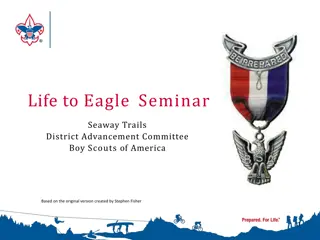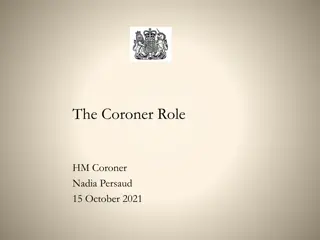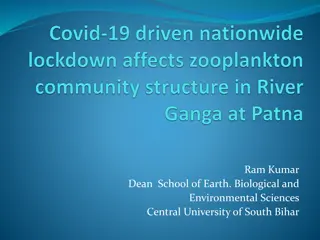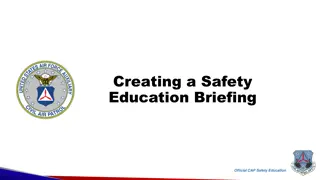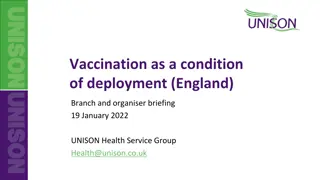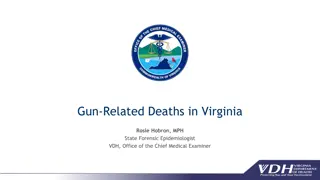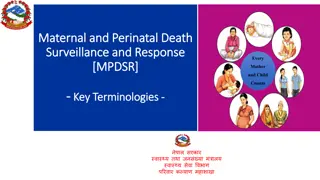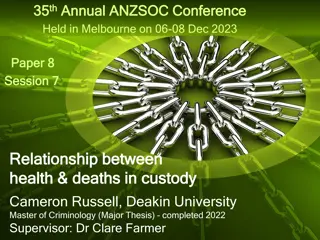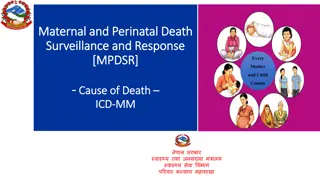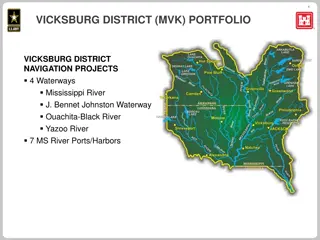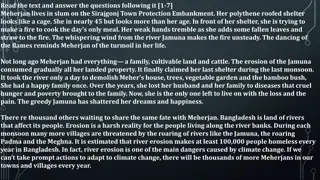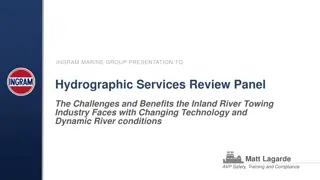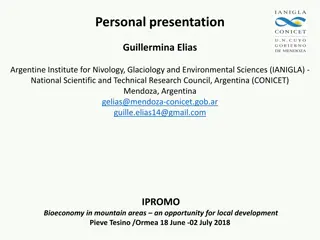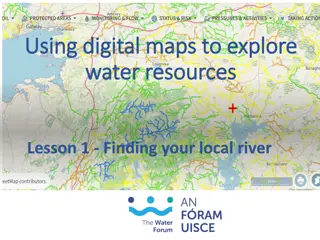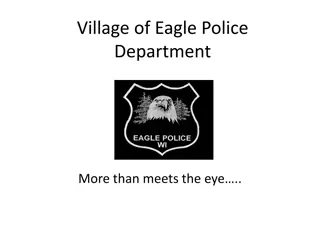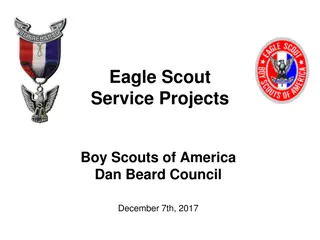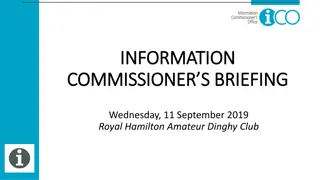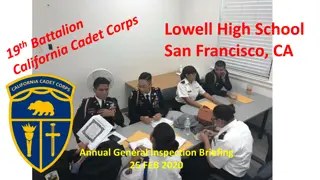Eagle River Waterfowl Deaths Environmental Case Study Briefing
Eagle River Flats, located in Alaska, has experienced high waterfowl mortalities since the early 1980s, raising concerns about environmental hazards. The area serves as a vital staging area for migrating waterfowl but has also been used for military activities, potentially impacting the ecosystem. This case study explores the causes, risks, and lessons learned from the waterfowl deaths at Eagle River Flats.
Download Presentation

Please find below an Image/Link to download the presentation.
The content on the website is provided AS IS for your information and personal use only. It may not be sold, licensed, or shared on other websites without obtaining consent from the author. Download presentation by click this link. If you encounter any issues during the download, it is possible that the publisher has removed the file from their server.
E N D
Presentation Transcript
ENV 201: Environmental and Pollution Science Case Study Briefing Instructions Grading Sample Presentation ENV 201- Environmental and Pollution Science 1
Instructions Step 1- Research and select a environmental case study Step 2- Provide subject to instructor NLT Class 2. Step 3- Research potential cases involving a environmental hazard (article, report or investigation). Step 4- Review EPA 40 CFR and EPA website for standard. Step 5- Prepare 15 minute PowerPoint presentation to be ready NLT Class 7. Include the following subjects: Overview Key Stakeholders Hazard(s) Risk Assessment Lessons Learned CFR Standards and Work Cited Step 6- Respond to peer and instructor questions. ENV 201- Environmental and Pollution Science 2
Grading Briefing is worth 12% (12 points) of your overall course grade Grading criteria includes: Student understood the work presented- Main ideas are clearly presented- Ideas are presented in the prescribe order- Ideas are supported by information and logic- Effective use of models, diagrams, charts, and graphs- 1 points Proper EPA 40 CFR standards were identified- Narration Briefing stayed within 15 minute timeframe (+/-1 min) 2 points 2 points 2 points 1 points 1 points 1 points 2 points 12 points ENV 201- Environmental and Pollution Science 3
Eagle River Waterfowl Deaths Sample Case Brief ENV 201- Environmental and Pollution Science 4
Agenda Overview Key Stakeholders Hazard(s) Risk Assessment Lessons Learned OSHA CFR 40 Standard(s) Work Cited ENV 201- Environmental and Pollution Science 5
Overview Show video Eagle River Flats (ERF) is an estuarine salt marsh located at the mouth of Eagle River, along the upper Cook Inlet, near Anchorage, Alaska. This 865-ha region, which is within the Fort Richardson Army Installation, serves as a staging area for the migrating waterfowl population during the spring and fall migration season. ERF has also been used by the U.S. Army as its primary munitions impact area for Fort Richardson since the late 1940s. http://erf.crrel.usace.army.mil/ ENV 201- Environmental and Pollution Science 6
Overview (2) High waterfowl mortalities at ERF were first noted in the early 1980s. An increased number of carcasses, as well as feather piles along the edge of the salt marsh, were the first indications that more deaths were occurring than in previous years. The species of birds that suffered the most mortalities were the dabbling ducks and swans. The cause of deaths could not be readily explained, and, in 1982, various government agencies joined efforts to further examine this problem. Eventually, an Eagle River Flats Interagency Task Force was established. http://www.sott.net/image/s8/179031/large/_e0 58b7165c01e9b3.jpg ENV 201- Environmental and Pollution Science 7
Overview (3) During the years 1983 through 1988, samples of water, sediment, and animal tissues from ERF were collected and analyzed. The water and sediment analyses did not show any major contaminants that could have led to waterfowl deaths. These findings were considered inconclusive. Since ERF was used as an artillery training area, components of various munitions were further investigated. ENV 201- Environmental and Pollution Science 8
Overview (4) In 1990, scientists began collecting samples and making detailed observations of where the birds were dying and of characteristic signs of poisoning. Analyses of sediment and water samples resulted in identification of two chemicals that are components of munitions used by the U.S. Army. The first compound, 2,4-dinitrotoluene (2,4-DNT), is one of the compounds in the M1 mixture that is the major component of a propellant; the other chemical, white phosphorus (WP), is used in smoke rounds. http://www.dot.state.mn.us/environment/images/hwy1sam ples.png ENV 201- Environmental and Pollution Science 9
Overview (5) More extensive analyses and laboratory experiments ruled out 2,4- DNT, but implicated WP as the cause. Scientists observed that laboratory ducks dosed with WP showed similar signs of intoxication as the sick ducks at ERF. Further, scientist found WP in the tissues of birds collected at ERF and in the sediments of shallow ponds that were frequently used by waterfowl. Contamination by munitions at ERF is not at all surprising, since the area has been used for artillery training for many years. http://i.telegraph.co.uk/multimedia/archive/0 1601/gaza-white-phospho_1601710a.jpg ENV 201- Environmental and Pollution Science 10
Overview (6) The persistence of WP (P4) in the environment was not expected. Because of the reactive nature of WP with oxygen, earlier studies of the smoke generated by burning white phosphorus predicted that WP would readily oxidize in air and that very little of the original form would be deposited into the terrestrial or aquatic environment. However, findings showed that the environmental conditions at ERF, including the soft, anoxic sediments and frequent deposition of sediment by flooding, all contributed to WP stability. ENV 201- Environmental and Pollution Science 11
Overview (7) Specifically, the point-detonating rounds left considerable amounts of solid white phosphorus particles in the saturated sediments of the pond bottoms. The shallow ponds and saturated sediments of a salt marsh are ideal for long-term storage of the millimeter-size particles of white phosphorus ejected from detonated mortar and howitzer shells. Therefore, the dabbling ducks foraging for food in ponds at ERF would most likely be ingesting WP particles as well as their normal diet of seeds and invertebrates. http://www.publicdomainpictures.net/pictures/6 0000/nahled/diving-duck.jpg ENV 201- Environmental and Pollution Science 12
Key Stakeholders Directorate of Public Works, U.S. Army Alaska (DPW US Army) U.S. Army Cold Regions Research and Engineering Laboratory (CRREL) Alaska District Corps of Engineers (AK COE) U.S. Environmental Protection Agency (US EPA) State of Alaska Department of Environmental Conservation (AK DEC) ENV 201- Environmental and Pollution Science 13
Risk Management Process ENV 201- Environmental and Pollution Science 14
Risk Assessment WP- Environmental Hazard Phosphorus_white.pdf Fate and Transport. Particles will settle due to gravitational forces an may sorb to particulate matter in water and be transported to sediment. Volatilization from water to air is another mode of transport. Persistence. Normally the estimated half-lives at ambient temperatures due to a combination of hydrolysis and oxidation reactions are 42 hours in air-saturated water and 56 hours in non air- saturated water. Initial Risk Level. Exposure- Artillery rounds left considerable amounts of solid white phosphorus particles in the saturated sediments of the pond bottoms. Toxicity- Lethal dose of white phosphours is on the order of 1 mg/kg of body weight, the ingestion of one particle can be fatal to a duck. ENV 201- Environmental and Pollution Science 15
Risk Assessment WP- Safety Hazard In the process of cleaning up the white phosphorus on ERT, the area had to cleared of unexploded ordnance (UXO). This had to be completed for safety reasons. The Flats continues to be used as an impact area during winter months, and the few UXOs that are found each are disposed of by the post explosive ordnance disposal detachment. Initial Risk Level. Probability- The Flats continues to be used as an impact area during winter months, and UXOs had to be disposed of by the post explosive ordnance disposal detachment. Multiple entries into the affectedarea. Effect- Explosion resulting in human loss of life or limb. ENV 201- Environmental and Pollution Science 16
Level of Risk Exposure Probability A A Toxicity Severity II I Initial Risk Hazard WP UXO EH EH Risk Rating Extremely High EH ENV 201- Environmental and Pollution Science 17
Dose Response Curves http://www.pwrc.usgs.gov/resshow/sparl1r s/sparl1rs.htm#HAZARD ENV 201- Environmental and Pollution Science 18
Lessons Learned Since 1980, an estimated 1,000 to 2,000 waterfowl deaths have been observed each year at Eagle River Flats. Anaerobic sediments of a wetland provide ideal conditions under which white phosphorus can persist indefinitely. Predators in ERF, such as eagles, ravens and gulls ingesting WP-contaminated are likely at risk. Human health risks through consumption of ducks shot in nearby Cook Inlet marshes were found to be minimal based on the analysis for WP in over 300 hunter-harvested duck gizzards. ENV 201- Environmental and Pollution Science 19
Standards and References 40 CFR Standards: In June 1994, ERF was placed on the National Priorities List (NPL) by the U.S. Environmental Protection Agency (USEPA). ERF became a Federal Superfund site, which mandates that the area be subject to the remedial response requirements of the Comprehensive Environmental Response, Compensation, and Liability Act (CERCLA) References: Racine, C.H., M.E. Walsh, C.M. Collins, D.J. Calkins and B.D. Roebuck (1992) Waterfowl mortality in Eagle River Flats, Alaska: The role of munition compounds. CRREL ERF History- ttp://erf.crrel.usace.army.mil/history/ ENV 201- Environmental and Pollution Science 20
Questions ENV 201- Environmental and Pollution Science 21
This document is 100% funded by a $2.2 million grant from the U.S. Department of Labor, Employment and Training Administration (TAACCCT). The product was created by the grantee and does not necessarily reflect the official position of the U.S. Department of Labor. The Department of Labor makes no guarantees, warranties or assurances of any kind, express or implied, with respect to such information, including any information on linked sites and including, but not limited to, accuracy of the information or its completeness, timeliness, usefulness, adequacy, continued availability, or ownership. This work is licensed under a Creative Commons Attribution 4.0 International License. ENV 201- Environmental and Pollution Science 22


